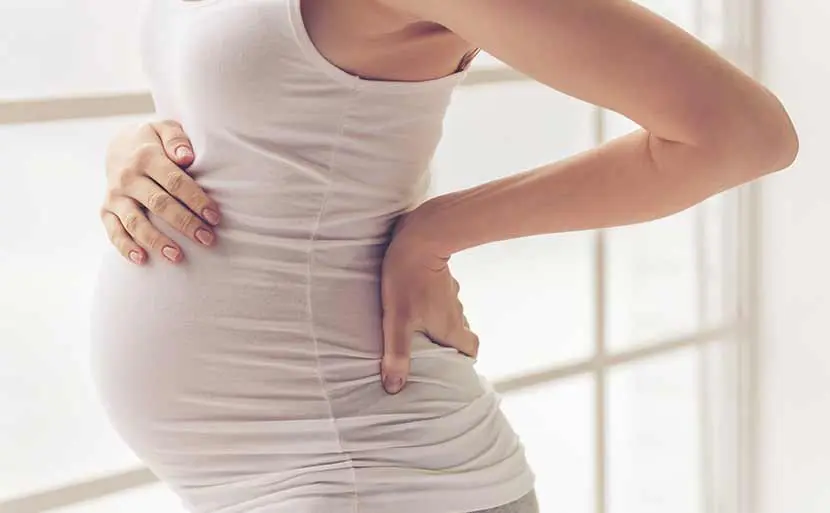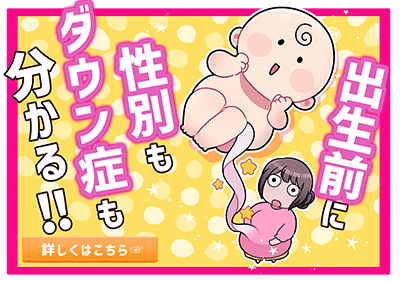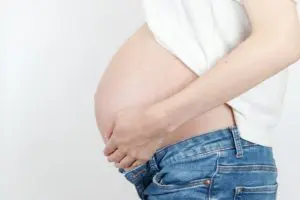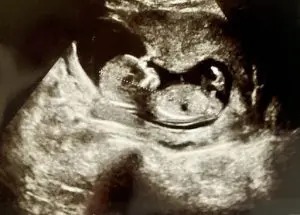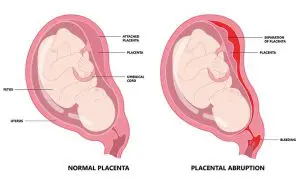Summary of This Article
During pregnancy, the hormone relaxin increases. This hormone loosens the joints in the pelvis, putting strain on the muscles of the lower back and causing back pain. Lower back pain can occur as early as the first trimester, and as the pregnancy progresses, the growing abdomen changes posture, increasing the strain on the lower back. Strategies to alleviate lower back pain include paying attention to sitting and standing posture, engaging in moderate exercise, sleeping on your side, and more. However, if the pain is severe, it is crucial to consult a hospital.
- Introduction
- Causes of Lower Back Pain During Pregnancy
- When Does Lower Back Pain Occur During Pregnancy?
- Types of Lower Back Pain During Pregnancy
- Strategies for Coping with Lower Back Pain During Pregnancy
- 1. Pay attention to your sitting posture
- 2. Be mindful of your standing posture
- 3. Use lower back pain relief products such as pelvic belts
- 4. Engage in moderate exercise
- 5. Side sleeping position
- 6. Avoid wearing high-heeled shoes
- 7. Soak in a warm bath to warm your body
- 8. Be cautious with the use of patches during pregnancy
- If the Pain is Severe, Consult a Hospital
- Conclusion
Introduction
It is not uncommon for pregnant women to experience lower back pain, with some reporting such intense pain that it hinders their ability to walk or move. While changes in body shape during pregnancy are commonly attributed to the onset of lower back pain, hormonal shifts in preparation for childbirth also contribute to its occurrence.
Let’s explore the causes of lower back pain during pregnancy and delve into preventive measures.
Causes of Lower Back Pain During Pregnancy
During pregnancy, the secretion of a hormone called relaxin increases. This hormone plays a role in loosening the joints at the junctions of the pelvis (such as the sacroiliac ligaments and pubic symphysis) to facilitate the baby’s passage through the birth canal during delivery. Consequently, the muscles in the lower back and spine bear the burden, leading not only to lower back pain but also potentially causing symphysis pubis pain.
Moreover, relaxin has a function to accumulate blood within the pelvic region, contributing to a sensation of heaviness around the lower back.
Due to these effects, the strain on the lower back increases during pregnancy, making individuals more prone to experiencing lower back pain.
When Does Lower Back Pain Occur During Pregnancy?
The hormone relaxin, which is responsible for causing lower back pain during pregnancy, increases from the early stages of pregnancy. Therefore, it is not uncommon for symptoms of lower back pain to appear in the early stages of pregnancy, when the abdomen is not yet significantly enlarged.
Types of Lower Back Pain During Pregnancy
The causes of lower back pain during pregnancy vary depending on the stage of pregnancy. The way the pain is experienced also tends to change as the weeks of pregnancy progress. Let’s explore the specific types of pain that may occur at each stage.
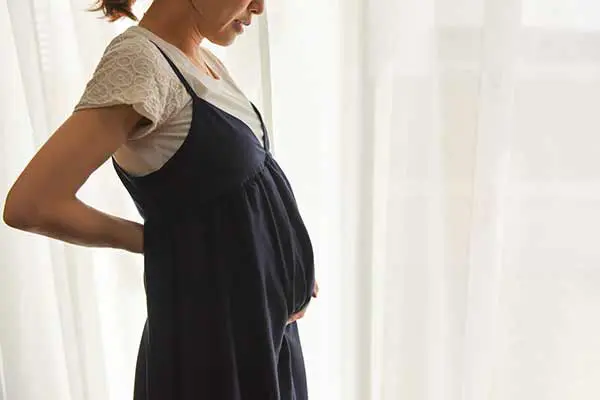
Very Early Pregnancy
Around the fourth week of pregnancy, which corresponds to the expected date of menstruation, the fertilized egg implants into the uterine lining. This leads to an increased secretion of relaxin, and as a result, some individuals may experience symptoms of lower back pain from this stage. It is common to feel a sense of heaviness in the lower back during this time.
Early Pregnancy
During the early stages of pregnancy, the secretion of progesterone, a female hormone, significantly increases alongside relaxin. Progesterone also has the effect of loosening the joints in the pelvis, contributing to the onset of lower back pain. It is not uncommon for pregnant individuals to experience symptoms of lower back pain around this time. Many may describe it as a dull ache with a sense of heaviness in the lower back.
NIPT (Non-Invasive Prenatal Testing) Can Be Done in Early Pregnancy
During the early stages of pregnancy, changes in the body and mental well-being are common. Concerns about the baby’s well-being and a safe delivery are often present. At such times, prenatal testing can be conducted to examine the baby’s condition in the womb.
There are several methods of prenatal testing. While amniocentesis and chorionic villus sampling provide definitive results, they involve the collection of amniotic fluid or placental tissue, posing a risk of miscarriage or stillbirth.
For non-definitive prenatal testing, there are NIPT, combined screening, and maternal serum marker screening. Among these, NIPT stands out with a high accuracy of 99.9% for both sensitivity and specificity in detecting Down syndrome (Trisomy 21). The test involves only a blood sample, eliminating the risk of miscarriage. Additionally, it can be conducted shortly after confirming the pregnancy through ultrasound.
If you’re curious about your baby’s well-being or experiencing anxiety, considering NIPT during this period may be a good option.
Mid Pregnancy
As you enter the mid-pregnancy phase, your abdomen expands, and your center of gravity shifts forward. To maintain balance, you may adopt a more arched posture, increasing the strain on your lower back.
Alongside hormonal changes, this shift in posture contributes to a higher likelihood of experiencing lower back pain during this period.
Late Pregnancy
In the later stages of pregnancy, similar to the mid-pregnancy phase, the increased risk of developing a lordotic (swayback) posture puts additional strain on the lower back. Moreover, during this period, the pregnant individual’s body weight is further elevated, intensifying the burden on the lower back compared to the mid-pregnancy phase.
Additionally, the enlarged uterus can compress blood vessels within the pelvic region, leading to reduced blood circulation. Difficulty in movement and a lack of physical activity can further contribute to poor blood flow. This compromised blood circulation becomes a contributing factor to lower back pain.
Furthermore, as the body prepares for childbirth, hormones such as relaxin and progesterone are released, making this period particularly susceptible to lower back pain.
The preparation for childbirth involves the loosening of the pubic symphysis, leading to instances of pubic symphysis pain.
Strategies for Coping with Lower Back Pain During Pregnancy
1. Pay attention to your sitting posture
When sitting down, it is crucial to maintain an upright position of the sacrum. Whether sitting in a chair or on the floor, be conscious of keeping the sacrum upright.
When sitting on the floor, positions like cross-legged or seiza (formal Japanese sitting) are recommended as they facilitate maintaining an upright sacrum position.
2. Be mindful of your standing posture
As the abdomen grows larger, there is a tendency to adopt a lordotic posture, which can be a cause of lower back pain. When standing up, try to gently engage the lower abdomen and be conscious of avoiding a lordotic posture to reduce the strain on the lower back.
3. Use lower back pain relief products such as pelvic belts
Many pregnant women struggle with lower back pain, and there are numerous products available to address this issue. Many of these products can be used postpartum as well, and some are even sold at maternity hospitals. If you are considering using any of these products, be sure to consult with your regular doctor before doing so.

4. Engage in moderate exercise
Moderate exercise can improve blood flow around the lower back, leading to relief from lower back pain. In addition to activities you can do on your own, such as walking, consider trying pregnancy-friendly exercises like maternity yoga or maternity workouts.
5. Side sleeping position
Sleeping on your back can put strain on your lower back. If you’re experiencing lower back pain, sleeping on your left side (left lateral position) with the left side of your body down can often provide relief. Using a body pillow or similar support can help maintain a comfortable position.
6. Avoid wearing high-heeled shoes
Wearing high heels or other elevated shoes can disrupt your body’s balance and place strain on your lower back. This can also increase the risk of falling. During pregnancy, it is advisable to wear low-heeled shoes to maintain stability and reduce strain on the lower back.
7. Soak in a warm bath to warm your body
Soaking in a hot bath can improve blood circulation around the lower back and help relax stiff muscles, providing relief from lower back pain. If you experience lower back pain, it’s recommended to take baths rather than relying solely on showers to enhance the benefits.
8. Be cautious with the use of patches during pregnancy
There are numerous types of patches that should not be used during pregnancy, especially in the later stages. If you are experiencing severe pain and wish to use a patch, it is crucial to consult with your primary healthcare provider rather than making decisions on your own.
If the Pain is Severe, Consult a Hospital
As seen throughout, while pregnancy-related hormonal changes and changes in body shape are common causes of back pain during pregnancy, severe back pain could also indicate a risk of miscarriage. If you experience intense or periodic pain, it is important to promptly seek medical attention and consult with a healthcare professional.
Conclusion
Many pregnant women experience back pain due to hormonal and body changes associated with pregnancy, and in most cases, it is not a cause for significant concern. While managing back pain through various strategies, it’s essential to navigate pregnancy with minimal discomfort.
However, if the back pain becomes severe or occurs periodically, it could be a sign of a potential miscarriage. In such cases, it is crucial to seek prompt medical attention.
Pregnancy involves various physiological changes, and while many discomforts are a normal part of the process, it’s important to consult with your regular healthcare provider if you experience severe or worrying symptoms.
Article Editorial Supervisor

岡 博史先生
【役職】
【資格】
【略歴】
【所属】
【SNS】
 中文
中文



